Want to bring out the hidden beauty of your rocks? This guide from rockscapes.net unveils simple methods to gloss rocks, transforming dull stones into stunning displays. From quick oil treatments to detailed polishing techniques, discover how to enhance your rock collection and create captivating rockscapes.
1. What is the Best Way to Gloss Rocks Quickly and Easily?
The best way to gloss rocks quickly and easily is by using oil. This simple method enhances the natural colors and textures of the rocks, providing an instant shine without the need for extensive equipment or time. It is perfect for hobbyists, homeowners, and anyone looking to beautify their rock collections or landscape features with minimal effort.
1.1 Why Choose Oil for Glossing Rocks?
Oil is an excellent choice for glossing rocks for several reasons:
- Simplicity: The process is straightforward and requires minimal materials.
- Speed: Results are immediate, providing a quick transformation.
- Enhancement: Oil brings out the natural colors and patterns in the rocks.
- Accessibility: The necessary materials are readily available and inexpensive.
- Versatility: Suitable for various rock types and sizes.
1.2 What Types of Oil Can You Use to Polish Rocks?
Several types of oil can be used to polish rocks, each with its own benefits:
- Mineral Oil: Food-grade mineral oil is a popular choice among experienced rock polishers. It is non-toxic and effectively enhances the shine and color of the rocks.
- Jojoba Oil: An environmentally friendly option, jojoba oil is another excellent choice. It is biodegradable and provides a lasting shine.
- Linseed Oil: Known for its ability to harden over time, linseed oil can provide a durable glossy finish. However, it should be used with caution due to its flammability.
- Tung Oil: Another natural oil that hardens to a durable finish, tung oil is often used for woodworking and can also be effective for rocks.
- Commercial Rock Polishing Oils: These are specifically formulated for rock polishing and can provide superior results.
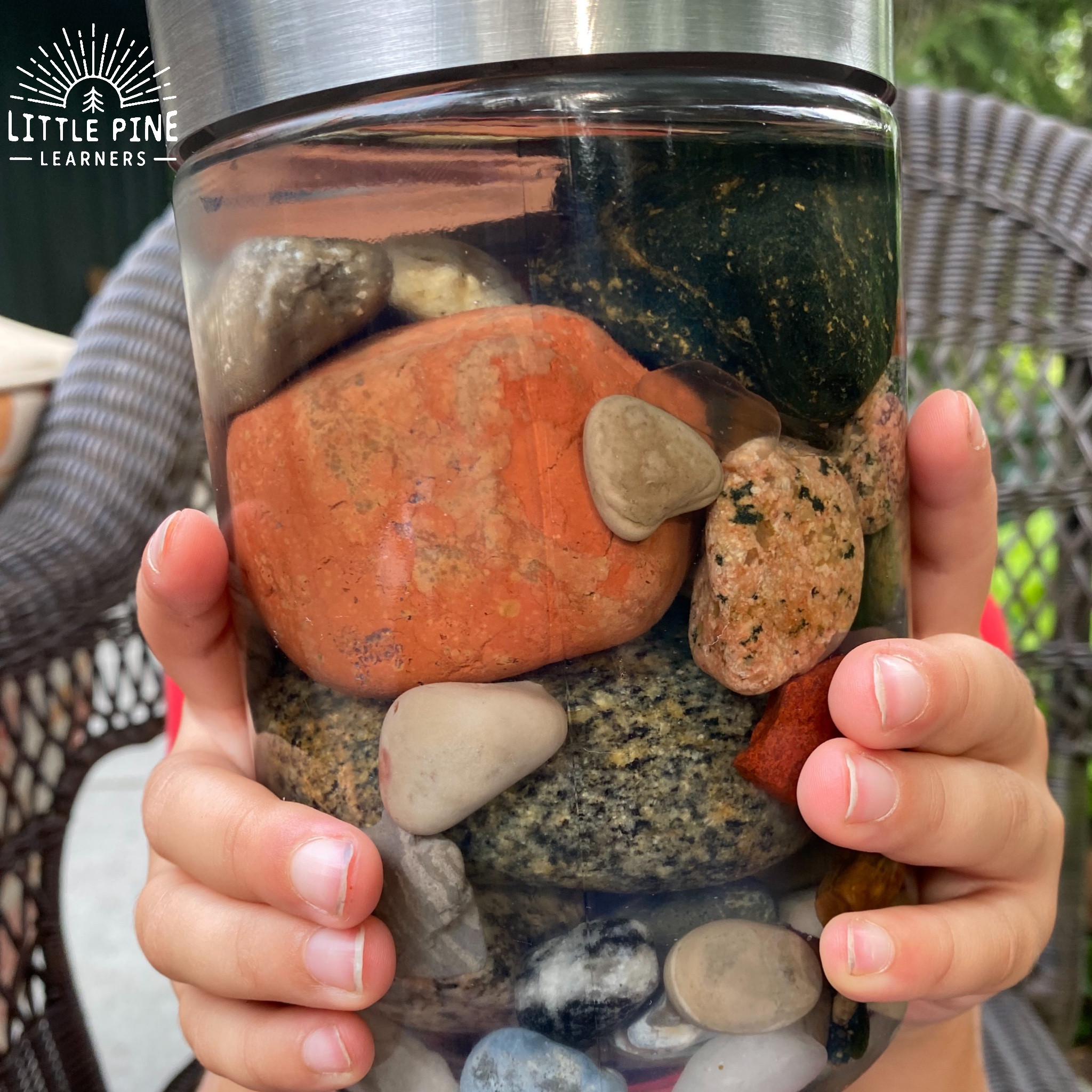 Rocks Polishing With Mineral Oil
Rocks Polishing With Mineral Oil
1.3 What are the Benefits of Using Rockscapes.net for Your Rock Polishing Needs?
Rockscapes.net offers a wealth of resources and inspiration for anyone interested in using rocks in their landscape or for decorative purposes. Here are some benefits of using Rockscapes.net:
- Diverse Selection of Rocks: Find various rock types perfect for any landscaping project.
- Expert Advice: Access tips and tutorials on rock polishing and landscaping.
- Inspiration: Discover design ideas to enhance your outdoor spaces.
- Quality Materials: Ensure your projects are durable with high-quality rocks.
- Community Support: Connect with fellow rock enthusiasts for ideas and advice.
2. What Supplies are Needed to Gloss Rocks with Oil?
To effectively gloss rocks with oil, you will need a few basic supplies. Having these items on hand will ensure the process is smooth and efficient, allowing you to achieve the best possible results.
2.1 Essential Supplies List
- Rocks: Gather the rocks you wish to polish. Ensure they are clean and dry before starting.
- Oil: Choose your preferred oil (mineral oil, jojoba oil, etc.).
- Jar or Container: A jar or container large enough to submerge the rocks in oil.
- Soap and Water: For cleaning the rocks before polishing.
- Strainer: To separate the oil from the rocks after soaking.
- Paper Towels: For initial wiping and removal of excess oil.
- Absorbent Towel: A soft, absorbent towel for the final polishing.
2.2 Where Can You Find These Supplies?
These supplies are readily available at various locations, making it easy to gather everything you need:
- Local Hardware Stores: Hardware stores typically carry a variety of oils, containers, and cleaning supplies.
- Craft Stores: Craft stores often have mineral oil and other supplies suitable for rock polishing.
- Online Retailers: Websites like Amazon offer a wide selection of oils, containers, and polishing cloths.
- Grocery Stores: Food-grade mineral oil can often be found in the health and beauty section of grocery stores.
- Rockscapes.net: For high-quality rocks and expert advice, visit Rockscapes.net to source your materials.
2.3 What Safety Precautions Should You Take When Handling Oil?
When working with oils, it’s important to take certain safety precautions:
- Ventilation: Work in a well-ventilated area to avoid inhaling fumes.
- Gloves: Wear gloves to protect your hands from prolonged exposure to oil.
- Eye Protection: Use safety glasses to prevent oil from splashing into your eyes.
- Flammability: Be aware of the flammability of certain oils (like linseed oil) and keep them away from open flames.
- Storage: Store oils in a cool, dry place away from heat and direct sunlight.
- Disposal: Dispose of used oil and rags properly to prevent environmental contamination.
3. What are the Step-by-Step Instructions for Glossing Rocks with Oil?
Glossing rocks with oil is a straightforward process that can be completed in just a few simple steps. This method is perfect for enhancing the natural beauty of your rocks quickly and easily.
3.1 Detailed Guide to Oil Polishing
- Wash and Dry the Rocks:
- Begin by washing the rocks with a light soap and water to remove any dirt or debris.
- Rinse the rocks thoroughly and allow them to dry completely. Placing them in the sun can speed up the drying process.
- Place Rocks in a Jar and Add Mineral Oil:
- Gently place the clean, dry rocks into a jar or container.
- Pour the oil over the rocks, ensuring they are completely submerged. The oil should cover all the rocks to ensure even polishing.
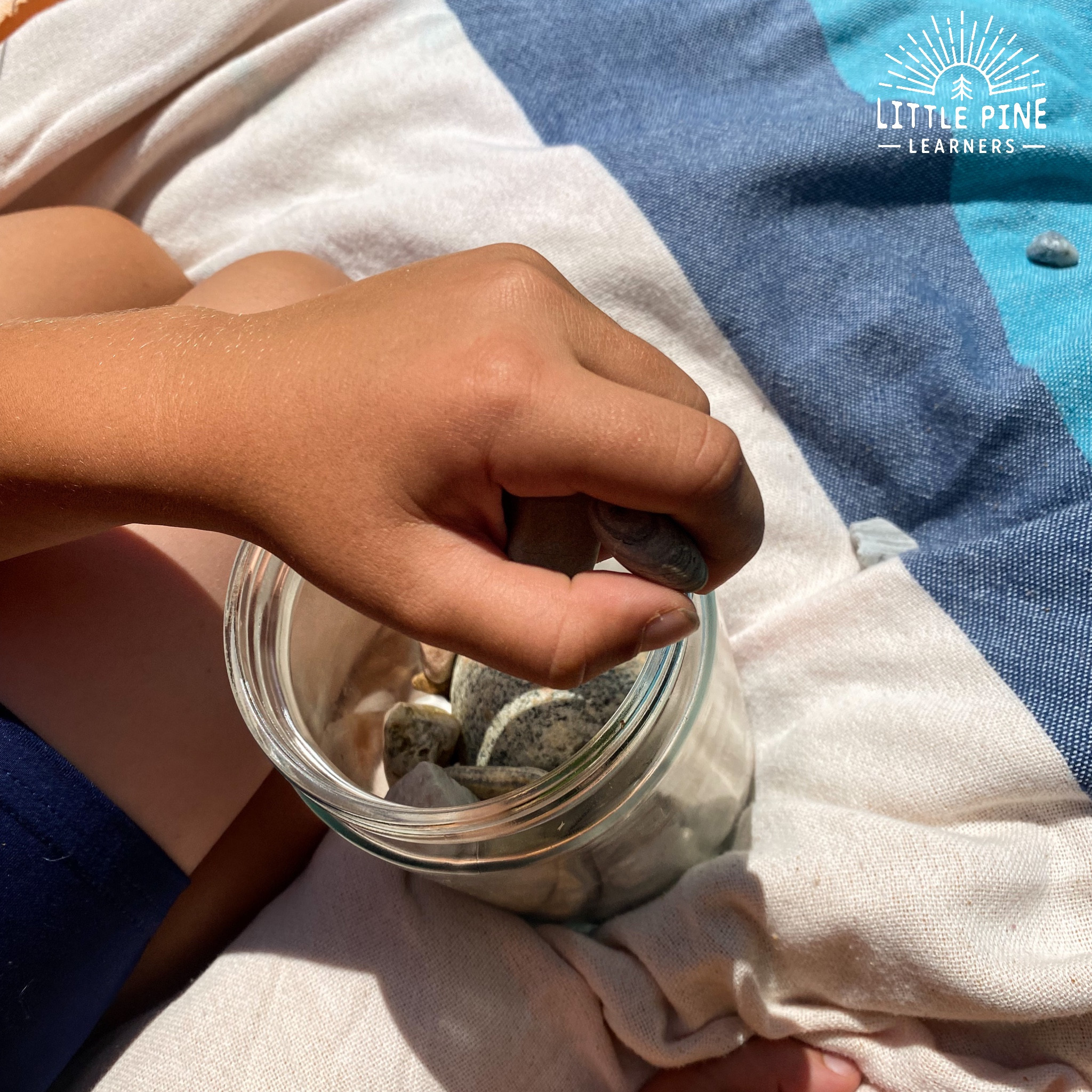 Place Rocks in a Jar
Place Rocks in a Jar
- Cover and Let the Rocks Sit in the Oil:
- Place a lid or cover on the jar to prevent evaporation and keep out dust.
- Let the rocks soak in the oil for at least two hours. For best results, you can leave them overnight. Soaking allows the oil to penetrate the surface of the rocks, enhancing their color and shine.
- Strain Oil:
- Place a bowl under a strainer to catch the used oil.
- Carefully pour the contents of the jar through the strainer, separating the rocks from the oil.
- Set aside the strained oil, as it can be reused for future polishing sessions.
- Polish with Paper Towel:
- After straining, the rocks will be quite oily. Use a paper towel to gently wipe off some of the excess oil.
- This step helps to remove the bulk of the oil and prepares the rocks for the final polishing.
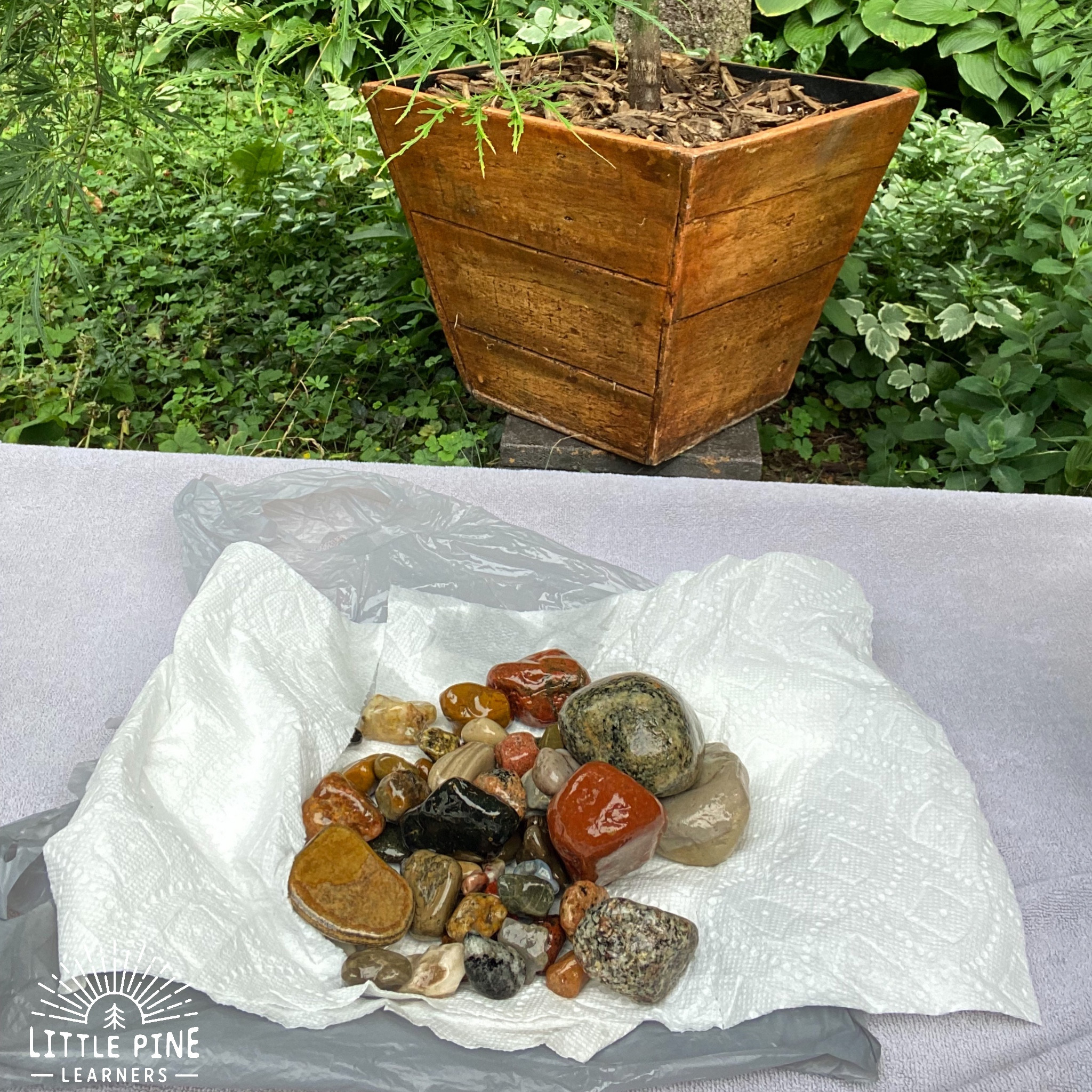 How to Make Rocks Shiny With Oil
How to Make Rocks Shiny With Oil
- Use an Absorbent Towel to Polish the Rocks:
- Take a soft, absorbent towel and begin to polish each rock individually.
- Wipe off the remaining oil, using a circular motion to bring out the shine. The towel will become stained with oil, so it’s a good idea to designate a specific towel for this purpose.
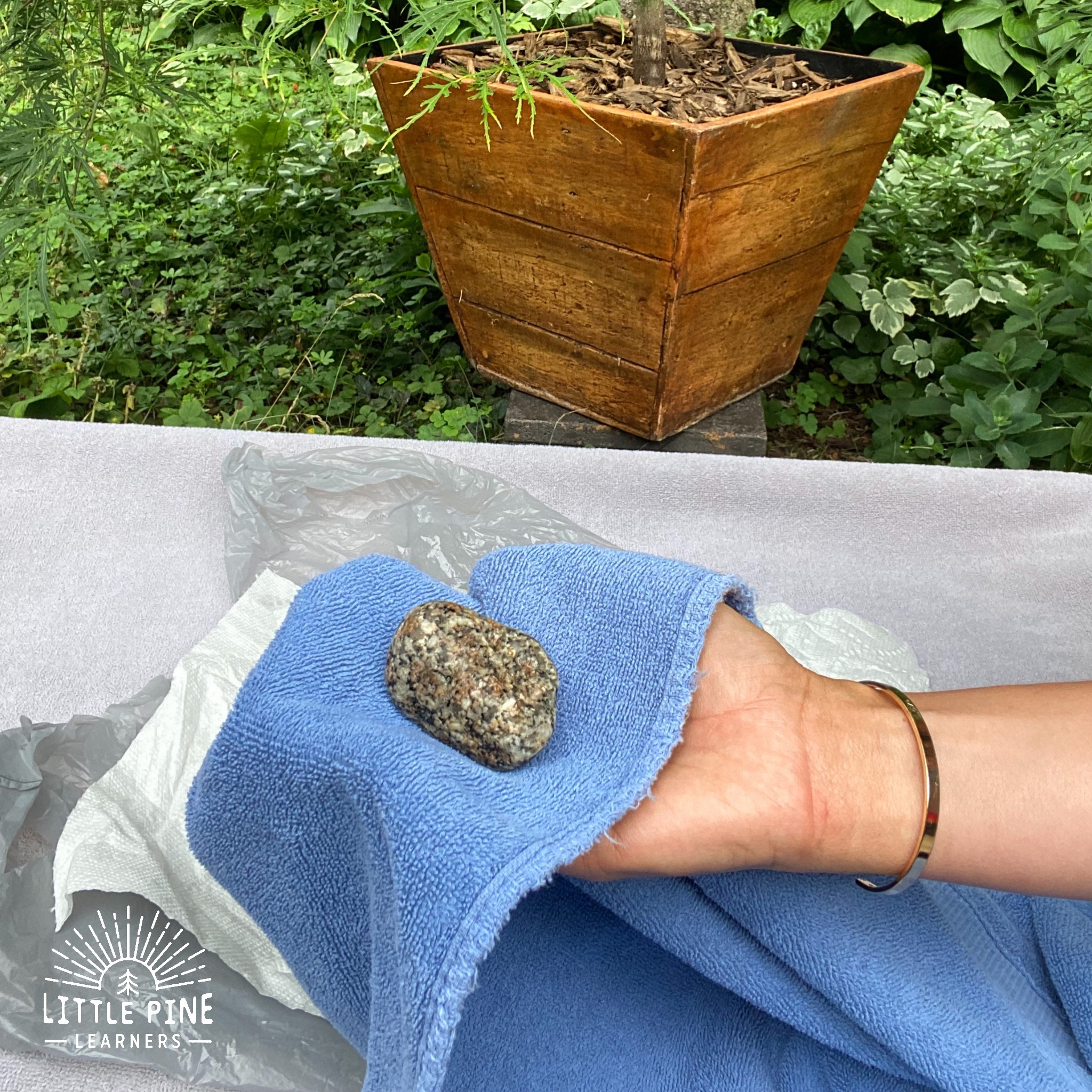 Stone Activity for Kids
Stone Activity for Kids
3.2 Tips for Achieving the Best Shine
- Use Clean Rocks: Start with thoroughly cleaned rocks to ensure the oil adheres properly.
- Submerge Completely: Ensure all rocks are fully submerged in oil for even coverage.
- Soak Time: Allow sufficient soaking time for the oil to penetrate the rocks.
- Gentle Polishing: Use a soft cloth and gentle pressure to avoid scratching the rocks.
- Reapply as Needed: If the shine fades over time, reapply oil for a refreshed look.
3.3 How Long Will the Shine Last?
The shine achieved by oiling rocks typically lasts for a few weeks. The duration can depend on factors such as the type of rock, the type of oil used, and environmental conditions. To maintain the shine, reapply oil as needed.
4. What are the Benefits of Glossing Rocks for Landscaping?
Glossing rocks for landscaping offers numerous aesthetic and practical benefits. Polished rocks can enhance the visual appeal of gardens, pathways, and water features, creating a more attractive and sophisticated outdoor space.
4.1 Aesthetic Advantages
- Enhanced Visual Appeal: Glossing rocks brings out their natural colors and textures, making them more vibrant and eye-catching.
- Improved Garden Aesthetics: Polished rocks can serve as focal points in gardens, adding a touch of elegance and sophistication.
- Increased Curb Appeal: Well-maintained and glossy rock features can significantly improve the overall appearance of your property.
- Versatile Design Options: Glossed rocks can be used in various landscaping designs, from minimalist to elaborate.
4.2 Practical Benefits
- Low Maintenance: Glossed rocks require minimal upkeep compared to other landscaping materials.
- Weed Control: Rocks can help suppress weed growth, reducing the need for frequent weeding.
- Erosion Control: Rocks can help stabilize soil and prevent erosion in sloped areas.
- Drainage: Rocks can improve drainage in gardens and around buildings.
- Durability: Rocks are highly durable and can withstand various weather conditions.
4.3 Design Ideas Using Glossed Rocks
- Garden Borders: Use glossed rocks to create attractive and defined garden borders.
- Pathways: Incorporate polished rocks into pathways for a decorative and functional element.
- Water Features: Enhance the beauty of ponds, fountains, and streams with glossy rocks.
- Rock Gardens: Create stunning rock gardens with a variety of polished stones and plants.
- Xeriscaping: Utilize glossed rocks in xeriscaping designs for a water-efficient and visually appealing landscape.
For more design inspiration and high-quality rocks, visit Rockscapes.net.
5. What Types of Rocks are Best Suited for Glossing?
Not all rocks are created equal when it comes to glossing. The best rocks for polishing are those that have a smooth surface and are relatively non-porous. These rocks tend to hold the shine better and showcase their natural colors and patterns more effectively.
5.1 Ideal Rock Types for Polishing
- Agate: Known for its vibrant colors and intricate banding, agate polishes beautifully.
- Jasper: With its wide range of colors and patterns, jasper is another excellent choice for polishing.
- Quartz: Including varieties like clear quartz, rose quartz, and amethyst, quartz rocks take a great shine.
- Obsidian: This volcanic glass has a smooth, reflective surface that is ideal for polishing.
- Petrified Wood: The unique patterns and textures of petrified wood are enhanced by polishing.
- River Rocks: Smooth, rounded river rocks are easy to polish and add a natural touch to any landscape.
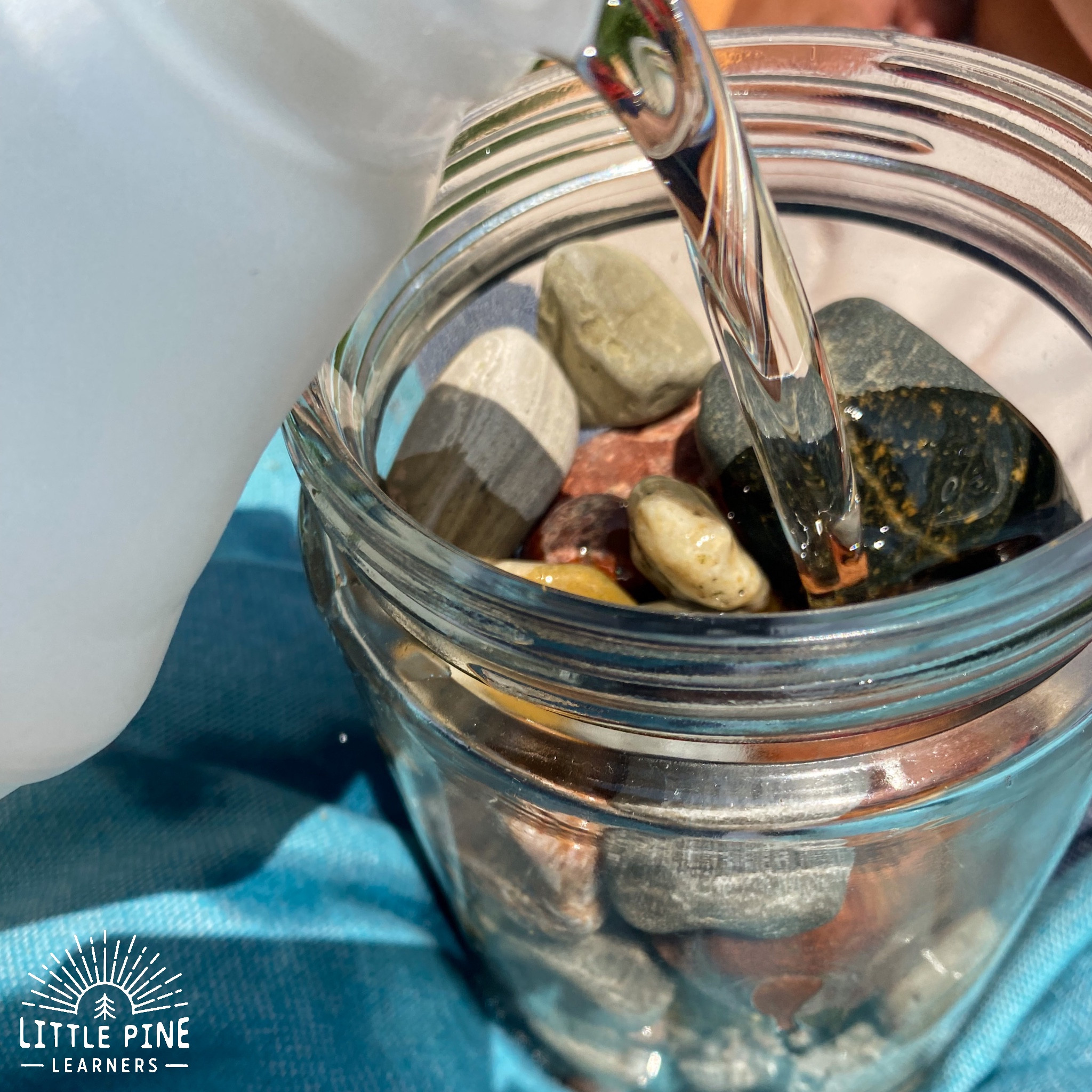 Add Mineral Oil to Rocks
Add Mineral Oil to Rocks
5.2 Rocks to Avoid
- Porous Rocks: Rocks with a porous surface, such as pumice or lava rock, do not polish well as they absorb the oil and do not retain a shine.
- Soft Rocks: Soft rocks like shale or sandstone can easily scratch and crumble during the polishing process.
- Rocks with Rough Surfaces: Rocks with very rough or uneven surfaces may require extensive grinding before they can be polished effectively.
5.3 Sourcing Quality Rocks from Rockscapes.net
For a wide selection of high-quality rocks perfect for polishing, visit Rockscapes.net. They offer a variety of rock types suitable for any landscaping or decorative project, ensuring you get the best materials for your needs.
6. How Does Rockscapes.Net Support Your Landscaping Projects?
Rockscapes.net is your premier destination for all things related to rocks and landscaping. Whether you are a homeowner, landscape designer, or contractor, Rockscapes.net provides the resources, products, and expertise you need to bring your vision to life.
6.1 Comprehensive Rock Selection
Rockscapes.net offers an extensive selection of rocks in various shapes, sizes, and colors. From decorative pebbles to large boulders, you can find the perfect rocks to complement your landscaping design.
6.2 Expert Advice and Guidance
The team at Rockscapes.net consists of experienced professionals who are passionate about rocks and landscaping. They can provide expert advice and guidance on selecting the right rocks, designing your landscape, and installing rock features.
6.3 Custom Rock Features
Rockscapes.net specializes in creating custom rock features, such as waterfalls, retaining walls, and rock gardens. Their skilled craftsmen can transform your outdoor space into a stunning oasis.
6.4 Delivery and Installation Services
To make your project as seamless as possible, Rockscapes.net offers delivery and installation services. They can deliver rocks directly to your property and handle the installation process, ensuring everything is done to your satisfaction.
6.5 Commitment to Sustainability
Rockscapes.net is committed to sustainability and responsible sourcing. They work with suppliers who adhere to ethical and environmentally friendly practices.
6.6 Real-World Examples of Rockscapes.net Projects
Rockscapes.net has successfully completed numerous landscaping projects throughout the United States. Here are a few examples:
- Residential Garden in Arizona: Rockscapes.net transformed a barren backyard into a lush garden with polished rocks, native plants, and a custom waterfall.
- Commercial Landscape in California: Rockscapes.net designed and installed a xeriscaped landscape for a commercial property, using drought-tolerant plants and decorative rocks.
- Public Park in Texas: Rockscapes.net created a natural play area in a public park with large boulders, climbing rocks, and a winding stream.
7. What Are Alternative Methods for Making Rocks Shiny?
While oiling is a quick and easy method for glossing rocks, there are several alternative techniques that can be used to achieve a more permanent and polished finish. These methods often require specialized equipment and more time but can produce stunning results.
7.1 Rock Tumbling
Rock tumbling is a popular method for polishing rocks that involves using a rotary tumbler to grind and polish the rocks over several weeks. The process typically involves four stages:
- Coarse Grinding: Rocks are placed in the tumbler with coarse grit to remove rough edges and shape the stones.
- Medium Grinding: Finer grit is used to smooth the surfaces and prepare the rocks for polishing.
- Fine Grinding: Even finer grit is used to further smooth the rocks and remove any remaining imperfections.
- Polishing: The rocks are tumbled with a polishing compound to create a glossy, reflective surface.
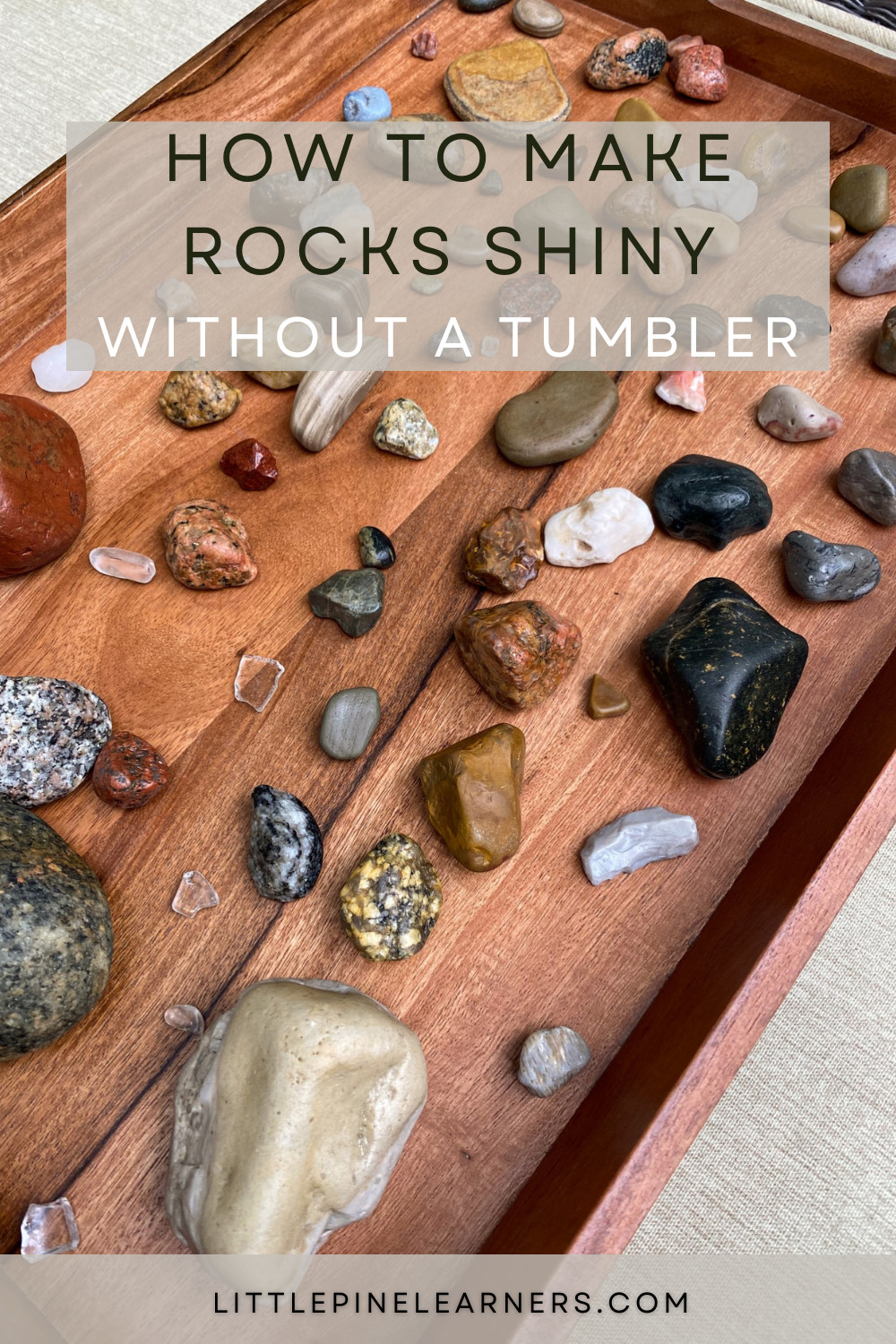 Shiny Rocks with Oil
Shiny Rocks with Oil
7.2 Lapidary Polishing
Lapidary polishing involves using specialized equipment, such as a lapidary wheel or flat lap, to grind and polish rocks. This method is often used for creating cabochons, faceted stones, and other gemstone shapes. The process typically involves:
- Shaping: The rock is shaped using a grinding wheel or saw.
- Smoothing: Progressively finer grit is used to smooth the surface of the rock.
- Polishing: A polishing compound is applied to a polishing lap to create a glossy finish.
7.3 Vibratory Tumbling
Vibratory tumbling is similar to rotary tumbling but uses a vibratory tumbler to polish rocks. This method is faster than rotary tumbling and is often used for polishing larger quantities of rocks. The process involves:
- Loading: Rocks are placed in the vibratory tumbler with abrasive media.
- Tumbling: The tumbler is turned on, and the rocks are vibrated against the abrasive media.
- Rinsing: The rocks are rinsed to remove any remaining media.
- Polishing: A polishing compound is added to the tumbler to create a glossy finish.
7.4 Which Method is Right for You?
The best method for polishing rocks depends on your budget, time commitment, and desired results. Oiling is a quick and easy option for enhancing the appearance of rocks, while tumbling and lapidary polishing provide more permanent and professional results.
8. How to Choose the Right Rocks for Your Project
Selecting the right rocks for your landscaping or decorative project is crucial to achieving the desired aesthetic and functionality. Consider these factors when choosing rocks:
8.1 Rock Type
Different types of rocks have different characteristics that make them suitable for various applications. For example, granite is a durable and weather-resistant rock that is ideal for retaining walls and pathways. Limestone is a softer rock that is often used for garden borders and decorative features.
8.2 Size and Shape
The size and shape of the rocks should be appropriate for the scale and design of your project. Large boulders can serve as focal points in a landscape, while smaller pebbles can be used for ground cover or drainage.
8.3 Color and Texture
The color and texture of the rocks should complement the surrounding environment and enhance the overall aesthetic of your project. Consider the colors of your plants, buildings, and other landscape elements when choosing rocks.
8.4 Availability and Cost
The availability and cost of rocks can vary depending on your location and the type of rock you choose. Local quarries and rock suppliers may offer a wider selection and lower prices than national retailers.
8.5 Tips for Sourcing Quality Rocks
- Visit Local Quarries: Local quarries often have a wide selection of rocks at competitive prices.
- Check Online Marketplaces: Online marketplaces like Craigslist and Facebook Marketplace can be a good source for finding used or discounted rocks.
- Contact Landscaping Suppliers: Landscaping suppliers can provide expert advice and quality rocks for your project.
- Consider Recycled Rocks: Recycled rocks, such as demolition debris or construction waste, can be a sustainable and cost-effective option.
9. What are Common Mistakes to Avoid When Glossing Rocks?
Glossing rocks can be a rewarding activity, but it’s easy to make mistakes that can affect the final result. Here are some common pitfalls to avoid:
9.1 Not Cleaning Rocks Properly
Failing to clean rocks thoroughly before polishing can leave dirt and debris trapped beneath the oil, resulting in a dull or uneven finish. Always wash rocks with soap and water and allow them to dry completely before proceeding.
9.2 Using the Wrong Type of Oil
Using the wrong type of oil can also affect the quality of the shine. Avoid using oils that are too thick or sticky, as they can attract dust and create a messy finish. Stick to light, non-toxic oils like mineral oil or jojoba oil.
9.3 Over-Polishing or Under-Polishing
Over-polishing can scratch the surface of the rocks, while under-polishing can leave them looking dull and lifeless. Use a soft cloth and gentle pressure, and check the rocks frequently to avoid these issues.
9.4 Neglecting Safety Precautions
Neglecting safety precautions when working with oils can lead to accidents or injuries. Always work in a well-ventilated area, wear gloves and eye protection, and keep flammable materials away from open flames.
9.5 Not Storing Rocks Properly
Failing to store polished rocks properly can cause them to lose their shine or become damaged. Store rocks in a cool, dry place away from direct sunlight and moisture.
10. How Can You Maintain the Shine of Your Glossed Rocks Over Time?
Maintaining the shine of your glossed rocks requires regular care and attention. Here are some tips for keeping your rocks looking their best:
10.1 Regular Cleaning
Clean your rocks regularly with a soft cloth and mild soap and water to remove dust and dirt. Avoid using harsh chemicals or abrasive cleaners, as they can damage the surface of the rocks.
10.2 Reapplication of Oil
Reapply oil as needed to maintain the shine of your rocks. The frequency of reapplication will depend on factors such as the type of rock, the type of oil used, and environmental conditions.
10.3 Protection from the Elements
Protect your rocks from the elements by storing them in a covered area or applying a sealant. Exposure to sunlight, moisture, and extreme temperatures can cause the rocks to fade or crack.
10.4 Proper Handling
Handle your rocks with care to avoid scratches or chips. Use gloves when handling rocks to prevent transferring oils from your skin to the surface of the rocks.
10.5 Inspection and Repair
Inspect your rocks regularly for any signs of damage, such as cracks or chips. Repair any damage promptly to prevent further deterioration.
10.6 Rockscapes.net Resources for Rock Maintenance
Rockscapes.net offers a variety of resources for maintaining the beauty of your rocks. Visit their website for tips, tutorials, and product recommendations.
Address: 1151 S Forest Ave, Tempe, AZ 85281, United States
Phone: +1 (480) 965-9011
Website: rockscapes.net
Elevate your landscape with the timeless beauty of polished rocks. Whether you’re aiming for a quick refresh with oil or a more lasting shine with advanced techniques, Rockscapes.net is your trusted partner. Explore our vast selection of rocks and expert guidance to bring your vision to life. Contact us today and let’s create a rockscape that captivates and endures.
Frequently Asked Questions (FAQ)
1. Is it safe to use mineral oil on rocks?
Yes, food-grade mineral oil is generally safe to use on rocks. It is non-toxic and does not harm the environment.
2. How often should I reapply oil to my rocks?
Reapply oil every few weeks or as needed to maintain the shine.
3. Can I use any type of oil on rocks?
It is best to use light, non-toxic oils like mineral oil or jojoba oil. Avoid using thick or sticky oils that can attract dust.
4. How long does the oiling process take?
The oiling process can take as little as a few hours, including soaking and polishing time.
5. Can I use this method on all types of rocks?
This method works best on smooth, non-porous rocks. Porous rocks may absorb too much oil and not retain a shine.
6. How do I clean rocks before oiling them?
Wash rocks with soap and water and allow them to dry completely before oiling.
7. What is the best way to store polished rocks?
Store polished rocks in a cool, dry place away from direct sunlight and moisture.
8. Can I use a rock tumbler instead of oiling?
Yes, a rock tumbler can be used to polish rocks for a more permanent shine, but it requires more time and specialized equipment.
9. Where can I buy high-quality rocks for polishing?
Visit rockscapes.net for a wide selection of high-quality rocks perfect for polishing.
10. How do I dispose of used oil properly?
Dispose of used oil properly by taking it to a recycling center or hazardous waste facility. Do not pour it down the drain or into the environment.